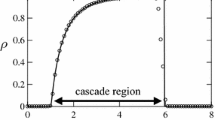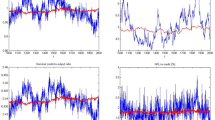Abstract
Using a dynamic network formation model, solved numerically, we study banks’ rollover decisions. We find that when the existence of linkages between market participants generates an informational externality, the newly formed network is conditioned by past architectures. Moreover, this inertia is strongly dependent on macroeconomic conditions, such as investors’ risk appetite. Simulations show that for intermediate values of the risk appetite’s parameter the financial network exhibits tipping points, i.e., the inability to maintain a threshold number of linkages may push the market into a gridlock. In this context, we study also how policy instruments, such as taxes and subsidies, affects debt rollover. Since a reduction in the policy level plays the same role as an improvement in economic fundamentals, the creation of interbank connections can be stimulated by it. Thus, in order to restart lending after a major stress situation in the interbank market a considerable reduction in the policy level is required, advising a counter-cyclical policy similar to the ones recently proposed with respect to capital requirements.






Similar content being viewed by others
Notes
We can think about this setup as a second stage of a broader game where borrowers offer a refinancing contract based on the rollover decisions of the lenders. However, this extension is left for future research.
In the special case in which random variables are jointly normally distributed, linear least-squares projections equal conditional expectations.
For a more complete distinction between risk aversion and appetite see Gai and Vause (2006).
References
Akram Q, Christophersen C (2010) Interbank overnight interest rates-gains from systemic importance. Norges Bank Working Paper
Allen F, Babus A (2009) Networks in Finance. In: Kleindorfer P, Wind J (eds) The network challenge: strategy, profit, and risk in an interlinked world. Wharton School Publishing, Philadelphia, pp 367–382. ISBN 0137011911
Allen F, Gale D (2000) Financial contagion. J Political Economy 108(1):1–33
Allen F, Babus A, Carletti E (2012) Asset commonality, debt maturity and systemic risk. J Financial Econ 104(3):519–534
Anand K, Gai P, Marsili M (2012) Rollover risk, network structure and systemic financial crises. J Econ Dyn Control 36(8):1088–1100
Banerjee A (1992) A simple model of herd behavior. Q J Econ 107(3):797–817
(2010) Countercyclical capital buffer proposal. Consultative Document, Bank for International Settlements, Basel
Caballero RJ, Simsek A (2009) Fire sales in a model of complexity. NBER Working Papers
Chen Y (1999) Banking panics: The role of the first-come, first-served rule and information externalities. J Polit Econ, pp 946–968
Cocco J, Gomes F, Martins N (2009) Lending relationships in the interbank market. J Financial Intermed 18(1):24–48
Coudert V, Gex M (2006) Can risk aversion indicators anticipate financial crises. Banque de France Financial Stab Rev 9:67–87
Coudert V, Gex M (2008) Does risk aversion drive financial crises? testing the predictive power of empirical indicators. J Empir Finance 15(2):167–184
Danielsson J, Zigrand J (2008) Equilibrium asset pricing with systemic risk. Econ Theory 35(2):293–319
Federgruen A (1978) On n-person stochastic games with denumerable state space. Adv Appl Probab, pp 452–471
Gabrieli S (2011) Too-interconnected versus too-big-to-fail: Banks’ network centrality and overnight interest rates. Tor Vergata University Mimeo
Gai P, Vause N (2006) Measuring investors risk appetite. Int J Cent Banking 2(1):167–188
Gordy M, Howells B (2006) Procyclicality in basel ii: can we treat the disease without killing the patient? J Financial Intermed 15(3):395–417
Hanson S, Kashyap A, Stein J (2011) A macroprudential approach to financial regulation. J Econ Perspect 25(1):3–28
Heider F, Hoerova M, Holthausen C (2009) Liquidity hoarding and interbank market spreads: The role of counterparty risk. European Banking Center Discussion Paper No 2009–11S, CentER Discussion Paper Series No 2009–40S
Kumar M, Persaud A (2002) Pure contagion and investors’ shifting risk appetite: analytical issues and empirical evidence. Int Finance 5(3):401–436
Nagurney A (2008) Financial networks. In: Handbook of Financial, Engineering, pp 343–382
Nagurney A, Dong J (2002) Supernetworks: decision-making for the information age. Edward Elgar Publishing Incorporated, Northampton
Nagurney A, Ke K (2001) Financial networks with intermediation. Quant Finance 1(4):441–451
Nagurney A, Toyasaki F (2003) Supply chain supernetworks and environmental criteria. Transp Res Part D Transp Environ 8(3):185–213
Page F, Wooders M, Kamat S (2005) Networks and farsighted stability. J Econ Theory 120(2):257–269
Page JFH, Resende JR (2012) The co-evolution of network structure, strategic behavior, and stationary dynamics. CAEPR Working Paper #2013-02, Department of Economics, Indiana University, Bloomington
Repullo R, Saurina J, Trucharte C (2010) Mitigating the pro-cyclicality of basel ii. Econ Policy 25(64): 659–702
Scheicher M (2003) What drives investor risk aversion? daily evidence from the german equity market. BIS Q Rev, pp 67–74
Shapley L (1952) A value for n-person games. Tech. rep, Rand Corp Santa Monica Calif
Shleifer A, Vishny R (2010) Unstable banking. J Financial Econ 97(3):306–318
Staum J (2009) Systemic risk components and deposit insurance premia. Northwestern University, mimeo
Tarashev N, Drehmann M (2011) Measuring the systemic importance of interconnected banks. BIS Working Papers
Tarashev N, Borio C, Tsatsaronis K (2009) The systemic importance of financial institutions. BIS Q Rev 75:87
Thore S (1969) Credit networks. Economica 36(141):42–57
Acknowledgments
The first author acknwoledges financial support from FCT Ph.D. scholarship SFRH/BD/62309/2009.
Author information
Authors and Affiliations
Corresponding author
Rights and permissions
About this article
Cite this article
Fique, J., Page, F. Rollover risk and endogenous network dynamics. Comput Manag Sci 10, 213–230 (2013). https://doi.org/10.1007/s10287-013-0172-8
Received:
Accepted:
Published:
Issue Date:
DOI: https://doi.org/10.1007/s10287-013-0172-8




